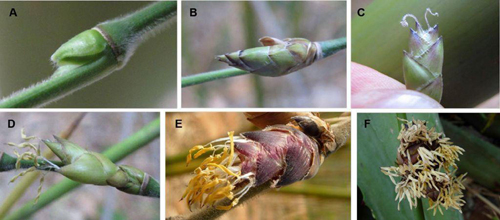Transcriptome sequencing can be used to determine gene sequences and transcript abundance in non-model species, and the advent of next-generation sequencing (NGS) technologies has greatly decreased the cost and time required for this process. Transcriptome data are especially desirable in bamboo species, as certain members constitute an ecologically, economically and culturally important group of mostly semelparous plants with remarkable flowering features, yet little bamboo genomic research has been performed.
Recently, staff and visiting scientists at Kunming Institute of Botany, CAS, headed by Prof. Dr. GUO Zhenhua and Prof. Dr. LI Dezhu, present extensive sequence and transcript abundance data for the transcriptome of developing flowers of a key bamboo species, Dendrocalamus latiflorus, obtained using the Illumina GAII sequencing platform. Approximately 96 million sequencing reads were generated and assembled de novo, yielding 146,395 high quality unigenes with an average length of 461 bp. Of these, 80,418 were identified as putative homologs of annotated sequences in the public protein databases, based on which 290 were found to be associated with the floral transition and 81 transcription factor families were identified. A further functional classification of these unigenes using a set of plant-specific GO slims identified a large number of important genes such as those involved in flower development (47), pollination (16), stress response (470), signal transduction (429), and regulatory and epigenetic genes (25), etc.. The KEGG (the Kyoto Encyclopedia of Genes and Genomes) pathway annotation predicted a great deal of crucial genetic pathways, including pentose and glucuronate interconversions, phenylalanine metabolism, carotenoid biosynthesis, flavonoid biosynthesis, flavone and flavonol biosynthesis and brassinosteroid biosynthesis. Digital abundance analysis identified 26,529 transcripts differentially enriched between two developmental stages, young flower buds and older developing flowers. Unigenes found at each stage were categorized according to their putative functional categories.
This work has been published online in PLoS ONE (2012, 7(8): e42082; http://www.plosone.org/article/info%3Adoi%2F10.1371%2Fjournal.pone.0042082). This study represents the first exploration of the D. latiflorus inflorescence transcriptome using large-scale high-throughput sequencing, and the results described herein may serve to guide further gene expression and functional genomic studies in bamboos. This research was supported by the Knowledge Innovation Project of the Chinese Academy of Sciences (KSCX2-YW-N-067); the National Natural Science Foundation of China (30990244); NSFC-Yunnan province joint foundation (U1136603); Scientific Research Foundation for the Returned Overseas Chinese Scholars, State Education Ministry and the Young Academic and Technical Leader Raising Foundation of Yunnan Province (No. 2008PY065, awarded to GUO Zhenhua); Yunnan Provincial Government through an innovation team program; the Western Light Talent Culture Project of the Chinese Academy of Sciences (No. 2010312D11035, awarded to ZHANG Xuemei).

Examples of sampled floral tissues. A. Representatives of flowers collected to produce the sample for phase 1 (flower buds ≤ 5 mm). B-F. Representatives of flowers collected to produce the sample for phase 2 (flower buds ≥5 mm). B. Flowers with pistils and stamens not yet emerging from glumes. C. Flowers from which only pistils have emerged from glumes. D. Flowers with both pistils and stamens emerging from glumes. E. Flowers for which anthers have already dehisced. F. Senescing flowers. (Image by KIB)




